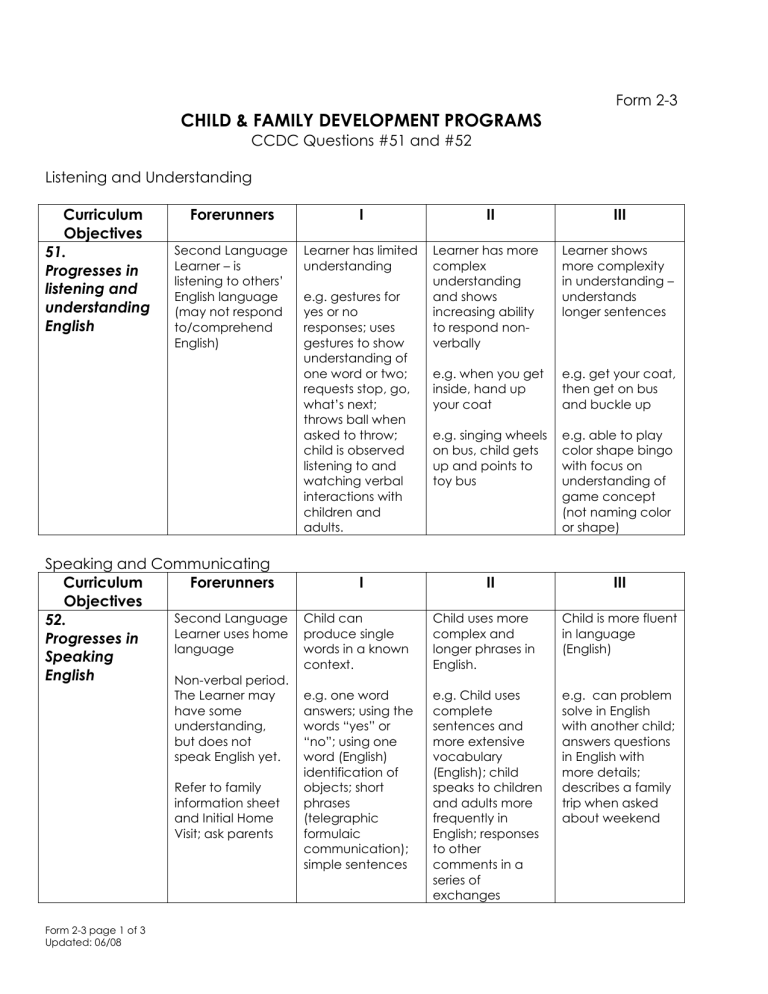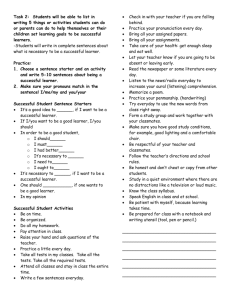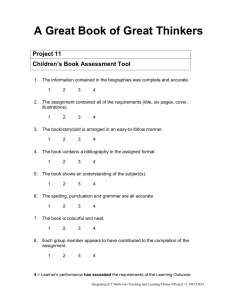LANGUAGE DEVELOPMENT (Second Language Learners)
advertisement

Form 2-3 CHILD & FAMILY DEVELOPMENT PROGRAMS CCDC Questions #51 and #52 Listening and Understanding Curriculum Objectives 51. Progresses in listening and understanding English Forerunners I Second Language Learner – is listening to others’ English language (may not respond to/comprehend English) Learner has limited understanding Speaking and Communicating Curriculum Forerunners Objectives Second Language 52. Learner uses home Progresses in language Speaking English Non-verbal period. The Learner may have some understanding, but does not speak English yet. Refer to family information sheet and Initial Home Visit; ask parents Form 2-3 page 1 of 3 Updated: 06/08 e.g. gestures for yes or no responses; uses gestures to show understanding of one word or two; requests stop, go, what’s next; throws ball when asked to throw; child is observed listening to and watching verbal interactions with children and adults. I II III Learner has more complex understanding and shows increasing ability to respond nonverbally Learner shows more complexity in understanding – understands longer sentences e.g. when you get inside, hand up your coat e.g. get your coat, then get on bus and buckle up e.g. singing wheels on bus, child gets up and points to toy bus e.g. able to play color shape bingo with focus on understanding of game concept (not naming color or shape) II III Child can produce single words in a known context. Child uses more complex and longer phrases in English. Child is more fluent in language (English) e.g. one word answers; using the words “yes” or “no”; using one word (English) identification of objects; short phrases (telegraphic formulaic communication); simple sentences e.g. Child uses complete sentences and more extensive vocabulary (English); child speaks to children and adults more frequently in English; responses to other comments in a series of exchanges e.g. can problem solve in English with another child; answers questions in English with more details; describes a family trip when asked about weekend Class Summary Worksheet Page 7 51. Progresses in listening and understanding English CHILDREN CHECKPOING TOTALS Fall □ Winter □ Spring □ Form 2-3 page 2 of 3 Updated: 06/08 F I II III 52. Progresses in speaking English F I II III LEARNING ENGLISH 51. Progresses in listening and understanding English Forerunner examples: I Learner has limited understanding II Learner has more complex understanding and shows increasing ability to respond non-verbally III Learner shows more complexity in understanding – understands longer sentences F W S 52. Progresses in speaking English Forerunner examples: I Child can produce single words in a known context II Child uses more complex and longer phrases in English III Child is more fluent in language (English) F W S Form 2-3 page 3 of 3 Updated: 06/08






